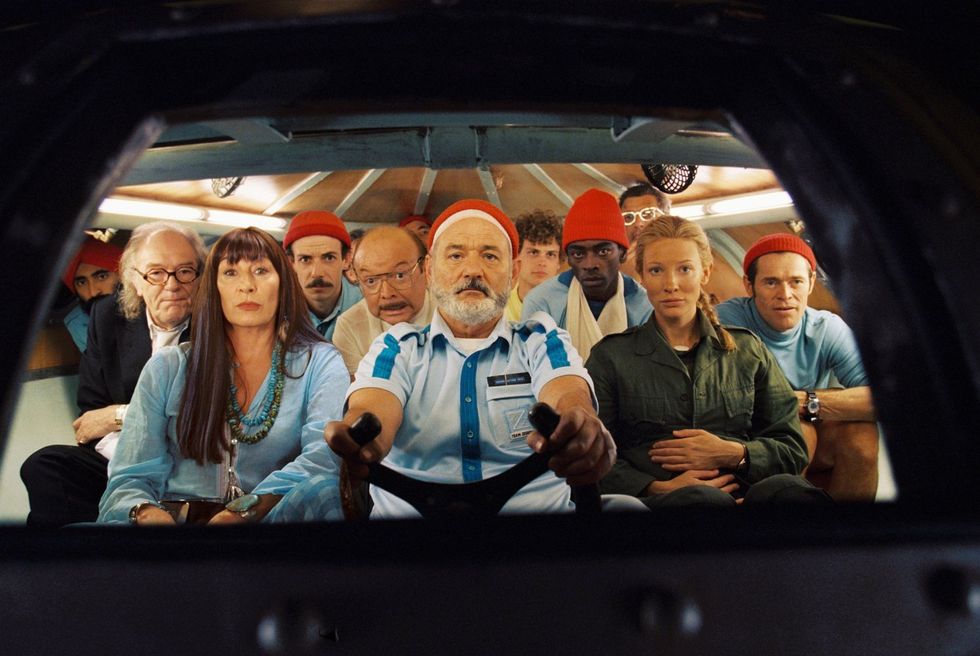“Anyway, I’m sorry. I know I haven’t been my best this past decade.” ~ Steve Zissou
The world premiere for Steve Zissou’s (Bill Murray) latest documentary is presented in a small Italian opera house. The film playing against a bright red curtain matches the color of the red sailor hats that Zissou’s crew wears. On the screen, Zissou treads water and screams, “Esteban! Esteban!” Zissou’s best friend and mentor, Esteban du Plantier, has been killed by the rare jaguar shark.
Zissou stands before the audience and announces he is planning a second expedition to hunt down the shark. A woman asks, “[The jaguar shark] is an endangered species at most. What would be the scientific purpose of killing it?” Zissou thinks about it for several seconds. “Revenge.”
Zissou isn’t as poetic as the famous Hamlet line, “Revenge his foul and most unnatural murder,” but the delivery is exactly what you’d expect from a Wes Anderson film. It’s blunt, straightforward, and like all Anderson characters, Zissou has a quirky habit to say exactly what he’s thinking (though maybe not what he means). Driven by vengeance and a ballooning mid-life crisis, Zissou leads a crew aboard the Belafonte into uncharted waters. His team includes: Ned Plimpton (Owen Wilson), a wide-eyed Kentuckian who claims to be Zissou’s long-lost son; Jane Winslett-Richardson (Cate Blanchett), a pregnant journalist; Klaus Daimier (Willem Dafoe), an emotional German who views Zissou as a father; and Pele dos Santos (Seu Jorge), a Brazilian musician who sings David Bowie songs.
The Secret Life of Steve Zissou (2004) isn’t Anderson’s greatest film. The Andersonian (yes, he has become his own genre) style isn’t as polished as his other works. Anderson loves to exchange clarity for style, and when it works, the effect is eccentric on the most captivating level. The biggest problem with The Life Aquatic is that Anderson’s panoramic cinematography and fragmented line delivery was often mistimed, pushing the plot’s meandering and character’s obscure dialogue uncomfortably to the forefront.
Where The Life Aquatic triumphs, though, is that for all the vague atmosphere, it creates a beautiful character arc with Steve Zissou. Murray’s depiction of a depressed middle-aged man (a role he seems to have occupied for the past few decades) evolves from sympathetic to contemptuous to tragic as he searches for new purpose in his life. The Life Aquatic probably could have been more direct on this metaphor, but I think of the jaguar shark as a representation for living life as it should be lived. A shark, however dangerous, is instinctive, following a set of rules that nature designed. Zissou, in contrast, lives his life like a circus showman, and it’s impossible to know whether he’s telling the truth or acting honestly. Even his career as a documentarian is thrown into doubt—a profession that is meant to provide an in-depth view of reality—as his movies are highly controlled and manipulated to create the best dramatic shot rather than truth. The relationship that grows from the Captain Ahab-ian adventure with Ned, and to a certain extent his whole crew, forces Zissou to reevaluate his own life—with all honesty—for the first time.
Again, The Life Aquatic definitely could have run a tighter ship, drawing in these metaphors in a clearer focus. The plot sometimes feels like it’s drowning under its own ramblings (the misplaced Philippine pirates the biggest weight), and though the characters are enjoyable, the supporting cast doesn’t provide enough depth to keep the movie afloat.
Rating: C+ | 2 stars
















